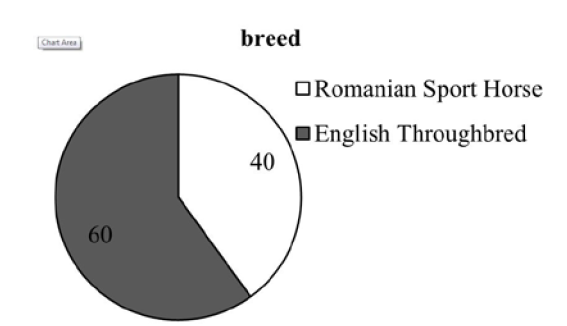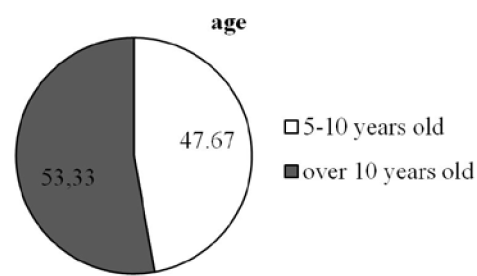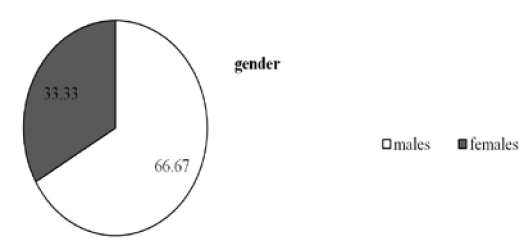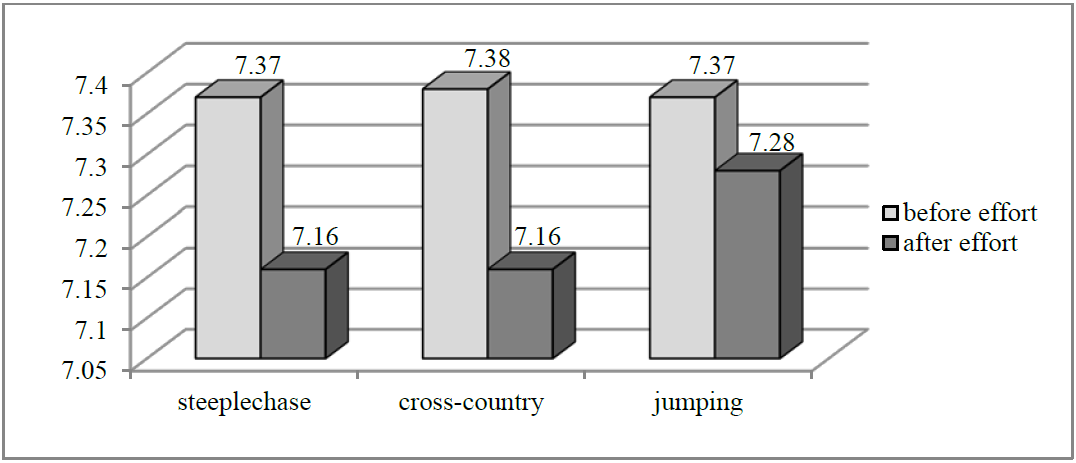Abstract
The purpose of this study was to reveal the pH content of blood in sport horses, in order to sustain the importance of equestrian sports for multidimensional education, as a interdisciplinary combination of veterinary medicine and sport. During equestrian competition, the chemical energy necessary to sustain the horse effort is synthesized in an overwhelming proportion through lactic anaerobe metabolic path. Biologic material used for research was represented by sport horses well trained for complete trials competitions (Eventing). To determine pH values, the test was conducted over 2 days (1-steeplechase and cross-country trials, 2-jumping trial). These kinds of trials require maximal and sub-maximal effort intensity and need both speed and jumping skills. From the horses participating in the test there were collected venous blood sample. The obtained values were statistically calculated and also there were determined the difference significations. pH values were based on the intensity of effort so that the maximal and sub-maximal efforts leans towards acidity (acidosis tendency), low and middle efforts towards alkalinity. The statistics allowed understanding the biochemical and physiological mechanisms that lead to poor results in horse sports. This phenomenon is common and represents a constant challenge for the physician, coach and horse owner for finding new training methods appropriate to obtain sports performance. On international level the importance of this topic is seen in the necessity of knowing the dynamic pH levels. These modifications appear during different types of training and trials. These researches lead to obtain horse performances but also to avoid illness situation.
Keywords: Cross-countryhorse-jumpingpHsteeplechasesport
Introduction
Hipic sport is seen by some authors as a science or an art, but the most horse lovers consider the
hipic sport as something more complex and complete, based on deep communication between horses
and humans.
Hipic sports or ridding art is helping to physical development of the riders, maintaining their health
and also to create good and moral features (courage, skills, optimism, and patience).
Lactic anaerobic metabolism path represents the basic source to support the chemical energy needed
to develop intense effort made by the sport horses during steeplechase and cross-country trials.
Sanguine pH decreasing, more pronounced in jumping horses, came to support this idea
After some authors blood pH tendency in similar conditions, is to decrease even below 7 (Snow,
Ricketts & Douglas, 1983).
There were obtained differences in pH values depending on the effort intensity, so that in maximal
and sub-maximal efforts the pH values tends to acidity and in low and medium effort intensity the trend
is to alkalinity. It can be said that in physical effort there is a metabolic acidosis.
These kinds of effort types require an increased intake of carbohydrate energy precursors available
in concentrated feed, but it must not be forgotten the negative consequences of carbohydrate hiper-
feeding such as: lowering the caecum-colic pH with destruction of cellulosolytic flora and reducing of
volunteer consumption of fibrouses along with consecutive decreasing of water and electrolyte
intestinal reserve. These can increase the risk of dehydration during effort (Reid Hanson, Pugh &
Schumacher, 1996). After some authors carbohydrate hiper-feeding favour overloading the muscle
fiber in glycogen, increasing the risk of rhabdomyolysis (Beech, 2000; Ghergariu, Giurgiu &Muscă,
1997; Harris, 1998).
Materials and methods
To determine the blood pH the complete trial competition was carried during two days. In the first
day, there was steeplechase and cross-country trials and in the second day there was horse-jumping
trial. The reason for choosing these trials was the maximal and sub-maximal effort intensity and the
exercises complexity, which meet both speed (over 600 m/minute) and enduring parts. Steeplechase
and cross-country are the most solicitant trials in complete trial competition.
During competition the weather was sunny with an average temperature of 24°C and relative
humidity of 48%. These meteorological dates were communicated by local meteorological station in
the competition day. From sport horses there were taken venous blood samples in 2 ml Li-heparin
vacuum tubes, 1 hour before trial and immediately after effort. There was avoided air bubbles and
atmospheric air contact. The samples for pH dosing were transported to the laboratory in cooler bags
(0-4 °C) and processed within 30 minutes after collection. Biologic material used for research was
represented by horses from Dinamo Club-Bucharest, animals which come from Jegălia and Cislău
livestock studs (table
were well trained for complete trials competitions (Eventing).
In the determination of the pH, the indicator electrode is the glass electrode and the reference one is
the calomel electrode. There is measured the potential difference which occur between the two
electrodes, that are immersed in researched solution and are separated from each other by a porous
membrane, establishing the electromotric force of formed galvanic cell. Thus, the pH is determined by
the potential difference occurring between the two electrodes, based on Nernst's equation
where: ZH + is the electric charge of hydrogen ions (= 1)
F is Faraday's number
R is the universal gas constant
T is the absolute temperature in Kelvin degree



Results and discussions
pH values in blood samples from horses were determined before and after complete trial
competition (steeplechase, cross-country and jumping trials). The values were statistically analysed
(table

The pH values decrease from 7,37 ± 0,006 before effort to 7,16 ± 0,011 after effort, at steeplechase,
from 7,38 ±0,01 to 7;16 ± 0,018 in cross-country. In horse-jumping, the pH value decreases a little less,
from 7,37± 0,008 to 7,28 ± 0,02.
There were calculated the signification of differences for pH values before and after effort,
comparing the three trials. The significant differences are presented in table
The results show that before effort, between compared trials, the differences are insignificant
After effort, the significant differences are various depending on the compared trials. Between
steeplechase and cross-country trials the differences remained insignificant, but between cross-country
and horse-jumping there are distinct significant differences and between steeplechase and horse-
jumping trials the differences are even very significant.
There was also calculated the signification of the differences between pH values, before and after
effort, in the same trial (table
In the same trial, before and after effort, there are very significant differences for steeplechase and
cross-country trials and there are distinct significant differences for horse-jumping
Both in human sports medicine as in sports skills breeds medicine (horse, camel, dog), one has tried
the scientific rationalization of training and physical activity methods, in order to objectively assess the
biochemical and physiological processes which will lead to a precise dimensioning of trainings length
and intensity. The blood ph changes may have an influence on the muscles activity, hence the necessity
to identify the values of this parameter depending on the physical effort, so that the training intensity to
be correlated with the requested sports performance. The awareness of these physiological and
biochemical processes will lead to the preservment of the health status and the improvement of sports
performances for the whole horse biologic material used for the equestrian performance sport, by
establishing an optimal training programme (daily and monthly) with the progressive increase of the
effort the animals are subjected to (the moving speed increase for the effort test or training for riding
trials different stages).
The importance of this experiment is due to understanding the biochemical and physiological
mechanisms that lead to poor results in horse sports. This phenomenon is common and represents a
constant challenge for the physician, coach and horse owner for finding new training methods
appropriate to obtain sports performance.
Conclusions
Analysing the result, there can be observed for all three trials, the metabolic acidosis tend for pH
blood samples. The pH blood values decreased after effort compared to values before effort. Before
effort the differences between pH blood values were insignificant, but after effort, in the same trial, the
differences were distinct or even very significant, due to the maximal effort intensity of the trials.
Between cross-country and steeplechase trials, after effort, the differences were insignificant because,
the pH averages had close values, the acidosis being already set up, due to the high effort intensity.
Horse-jumping trial presents the lowest differences between the pH values before and after effort. That
means that this trial put the horses to a submaximal effort, compared to steeplechase and cross-country
trials, but the effort has enough intensity in order for differences to obtain have distinct significations.
The data collected in this experiment allowed a better understanding of the biochemical and
physiological mechanisms that lead to poor results in horse sports. This phenomenon is common and
represents a constant challenge for the physician, coach and horse owner for finding new training
methods appropriate in obtaining sports performance.
References
- Snow, D.H., Ricketts, S.W., &Douglas, T.A. (1983).Post-race blood biochemistry in thorough breds. In: Snow D.H., Persson S.G.B., Rose R.J. (eds): Equine Exercise Physiology: Cambridge, Granta Editions, 389.
- Reid Hanson, R., Pugh, D.G., &Schumacher, J. (1996).Feeding equine athletes.Nutrition Research Reviews, 18(2), 175-182.
- Beech, J. (2000). Equine muscle disorders 1: Chronic intermittent rhabdomyolysis. Tutorial Article.Equine Vet. Ed. 12(3), 163-167.
- Ghergariu, S., Giurgiu, G., &Muscă, M. (1997).Elementele de patologie nutriţională şi metabolică la animale. Cluj-Napoca: Genesis.
- Harris, P.A. (1998). The Equine Rhabdomyolysis Syndrome. In W.B. Saunders, ”Metabolic and Endocrine Problems of the Horse”, Cambridge, 75-99.
Copyright information

This work is licensed under a Creative Commons Attribution-NonCommercial-NoDerivatives 4.0 International License.
About this article
Publication Date
04 October 2016
Article Doi
eBook ISBN
978-1-80296-014-3
Publisher
Future Academy
Volume
15
Print ISBN (optional)
-
Edition Number
1st Edition
Pages
1-1115
Subjects
Communication, communication studies, social interaction, moral purpose of education, social purpose of education
Cite this article as:
Şovarel, E. (2016). Research Over Blood pH Dynamic Values in Horses used in Complete Trial Competitions. In A. Sandu, T. Ciulei, & A. Frunza (Eds.), Logos Universality Mentality Education Novelty, vol 15. European Proceedings of Social and Behavioural Sciences (pp. 899-904). Future Academy. https://doi.org/10.15405/epsbs.2016.09.112

